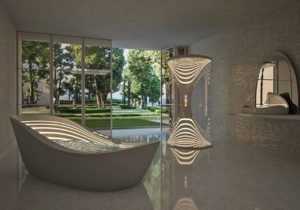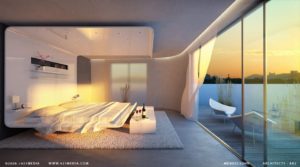Blog
By Mike Peterson

Courtesy Apple
The workplace thrives with Design Harmony.
The medical community prescribes Design Harmony.
Nations around the world emphasize Design Harmony.
Designers, it’s time that you, too, get credit for creating the health and wellness benefits inherent in Design Harmony!
The most exciting development in the design industry today is the recognition that great design improves health and wellness in the home. This is called Design Harmony, and it’s a curriculum that teaches this important idea: When interior designers create environments that are beautiful and well-designed, it encourages health and wellness.
For years we have known, anecdotally, that good design makes us feel better. That idea is no longer anecdotal. It’s now proven. Neuroaesthetics is a relatively new term that looks at the neurological response we have to art, design and beauty.
We know, for instance, that when we see something of beauty, we get a shot of serotonin in our brain. When we do, we feel better. Alternatively, when we see something disturbing and unattractive, we get a shot of cortisol, a hormone that helps us cope with negative imagery. When you produce beauty in your designs, you are improving the psychological and emotional welfare of your clients by increasing their serotonin levels and decreasing the amount of cortisol the body produces.
The other term that’s important to understand when studying Design Harmony is biophilic design. Biophilia, or biophilic design, uses the look and feel of nature in the home environment. Woods, cylindrical lines, greenery, natural light and burbling water are just a few of the emotional stimulants designers can use.
Design Harmony is not to be confused with the other wellness-related programs currently influencing the world of design. LEED, the Sustainable Furnishings Council’s GREENleaders program and the WELL Building Standard focus on sustainability and the certifiability of a product’s influence on health and wellness. Design Harmony is not about the physical; it is about the emotional and psychological rewards that great residential design produces.
A Prescription for Nature

The medical industry in many Far East countries are well ahead of the states in incorporating healthy design into the home environment. In the 1980s, Japan, for instance, began to implement the idea of shinrin yoku. Shinrin yoku is the Japanese word for “forest bathing,” or the medicine of simply being in the forest.
Note that I say “medicine.” In the Far East, doctors now prescribe forest bathing as a medicinal alternative to a bottle of pills. It has become a cornerstone of preventive healthcare and healing in Japanese medicine. (In a way, shinrin yoku is a sibling to biophilia. Biophilic design means bringing nature into the home, and shinrin yoku means going out into nature.)
Medical associations in countries like Canada and the U.K. are incorporating design benefits as medicines. On November 1, 2018, the medical group Médecins francophones du Canada began allowing doctors to prescribe visits to museums, design centers and art galleries as a remedy for selected ills. In the U.K., doctors are employing what they call “social prescribing,” which includes immersing the patient into multiple arts and cultural experiences.
Doctors here are becoming more aware of the benefits of good design. In her thesis, Dr. Claudia Miller from the University of Texas School of Medicine stated, “Architects and designers have a greater ability to improve public health than medical professionals.” Lowering stress through design is a preventative approach to good health that helps offset the need for medical intervention.
Working for Better Interiors

Why is commercial design so far ahead of residential design when it comes to healthy environments? Major companies want productivity and increased creativity and learned years ago that by providing a health-based environment they will increase both.
A recent study of 7,600 workers in 16 countries found that those who worked in spaces with green or other natural features reported a 15 percent higher level of wellbeing, 6 percent more productivity and 15 percent more creativity. Increasing productivity by 6 percent increases a company’s annual profit by $3,395 per employee every year. This fact alone is why companies like Apple, Amazon, Etsy and so many more are incorporating healthy design principles into the work environment.
Getting Started with Design Harmony
As Americans of all ages become increasingly focused on health and wellness, they are looking for service providers who share their values and interests. By incorporating Design Harmony into your business, your value to your client multiplies. Increased value means increased revenue.
How can you take better advantage of the groundswell of the Design Harmony movement? It starts by making sure that your design creates those “aha” moments for your client—those moments that will provide them with a shot of serotonin. To do that, we have developed a series of questions that you may want to ask in the early stages of research with the client. Some examples are:
- Please describe, in general, what makes you happy in life and in your home.
- What kind of a relationship do you want to have with your home environment?
- How much time do you spend at home? Day hours? Evening hours?
- How do you want to feel in your home
- Where do you love to travel? What are your favorite things to do on vacation?
- What is your vision for your space? Answer with emotions and feelings.
- What about your significant other drives you crazy?
While the last question may put a smile on your face, it’s important to note that eliminating existing anxiety is very much a part of Design Harmony’s mission. It is not just about providing beauty and alluring imagery; it is about creating an environment that lowers stress and yields health and wellness.
Each one of these questions will provide an answer to guide how you design—based on feelings and emotional rewards, not just color preference and space planning.
You Need to Market the Health Benefits
Adding just a few words to your marketing materials will also help position you as differentiated from your competition and increase your value proposition. A few key phrases, such as “peace of mind,” “your needs and emotions” and “your health and wellness” will show prospective clients that you offer more than just design. Here’s an example of website text that was improved by using just a few health- and wellness-based phrases:
At ABC Design Studio, we work closely with our clients to create home interiors that provide pleasure and healthy environments. We are a full-service design studio with a personal approach to your needs and emotions. It’s your peace of mind that’s important as you let us handle all the necessary details. Your health and wellness in your home is our goal.
The design industry has always offered more than color, fabrics and balance. We provide joy, happiness and fulfillment. We spread well-being and health to all our clients. There’s never been a better time to highlight that fact—which is now documented and no longer just a feeling. So, I urge you to realize the new opportunity in front of you. Learn from workplace design, the medical industry and countries around the world and embrace the Design Harmony curriculum. Becoming a steward of its concepts will add value to your business.
Interested in learning more about
Design Harmony?
Check out these books or find links to articles and research papers on our website, wf-vision.com.
- “Beauty, Neuroscience, and Architecture: Timeless Patterns and Their Impact on Our Well-Being”
by Donald H. Ruggles - “Natural by Design: People, Natural Process, and Ecological Restoration”
by Eric Higgs
Courses on
Design Harmony
To learn more about the Design Harmony CEU course offered by Visionary Design Marketing, click the button below.
